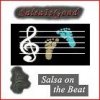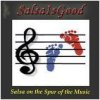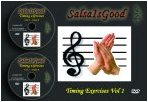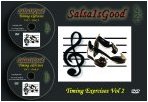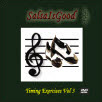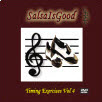
Salsa on the Spur of the Music!! |
|
|||||||||
| Music Timing, music interpretation and spontaneity in Salsa Are you getting so busy learning figures and shines that you forget to actually dance? Then this video is for you!! |
||||||||||
|
 |
|
|
"This dvd teach's Master level timing secrets which will help any Salsa student progress to the Master level. "Thank you so much for your work. I just finished watching "Salsa on the spur of the music" and it has completely changed the way I view dancing and leaning salsa. I've been taking classes for a year in Bermuda and your DVD has helped me to only just begin the journey of truly feeling the music when I dance. Particularly the dance clip at the beginning of Stacy Lopez dancing with his wife. I've watched this clip numerous times and shown it to all my friends. It is truly inspirational, I went dancing later in that night and I swear I could feel a difference" (Jamael, jamaelt_at_gmail.com) "This video is UNIQUE for the information it provides" (Luca, luca@venetiastudium.com) ".... It doesn´t exist any comparable product on the market". (Alex, alexander.kuechler@onlinehome.de) "Your dvd on the spur of the music is one of the best dvds i ve seen, you get to know things that others probably accumulate through years of experience" (vasilios, v_vazakas@hotmail.com) |
| ....and click here to read more testimonials! |
 |
|
 |
||||||||||||
What will I get from this video? |
|
|
 |
| DVD - $30 | |
 |
|
 |
|
| Salsa Timing Package - Testimonials (Salsa on the Spur of the Music + Salsa on the Beat) |
top |
"Thank you so much for your work. I just finished watching "Salsa is Good - Salsa on the spur of the music" and it has completely changed the way I view dancing and leaning salsa. I've been taking classes for a year in Bermuda and your DVD has helped me to only just begin the journey of truly feeling the music when I dance. Particularly the dance clip at the beginning of Stacy Lopez dancing with his wife. I've watched this clip numerous times and shown it to all my friends. It is truly inspirational, I went dancing later in that night and I swear I could feel a difference" (Jamael, jamaelt_at_gmail.com) "I've researched a few timing systems for Salsa music, and I like your CD the best" (Jemadean, salsapasion_at_earthlink.net) "Salsa on the Spur of the Music is my absolut best DVD, I love it. Till now I watch it 3 times and I will watch it more. (Wiltrud, wiltruds @ gmx dot de) "The Salsa on the Beat CD is very good. It is the best I have found. That is why I keep ordering more" (karl, broomekf at_earthlink net) "super CD Salsa on the beat - exactly, what I was looking for." (The customer wishes to remain anonymous) "Your "Salsa on the Beat" CD is excellent. Like many other people, I went through months of Salsa lessons, but did not have a clue of how to hear the beat or how to find the 1 and 5. Your CD helped me understand what to listen for. Now I can find the 1 and 5 in most songs. Dancing on time is still a challenge, but I am making progress. At least I hear the beat." (Karl broomekf at earthlink . net) "A must to have CD for people like me who just can't understand the beats. It made a huge difference to me. I never knew what I was looking for, when listening to a salsa song. I could dance to the counts, but the moment a music is ON I used to be lost. Now I know and I am happy that I decide to buy the CD. It is really worth it..... " (Anil) "I thought the CD was outstanding. For years I struggled to find the "one" in salsa.
Finally an instructor told me about the Salsa is Good CD. "The DVD is wonderful. I love that way it explains the different instruments and Stacy and Lucy the effortless way they dance with joy. " (Elva, ElvaRamirez01_at_hotmail.com) "As a starting point of every effort related to the salsa dance I
consider Salsa on the Spur of the Music, because you answer the basic "..we are right into salsa on the beat and salsa on the spur of music, and both are great! So far we had no time to look into the other dvds, but these two alone are worth it!" (Sam, sam_at_radeldudel.de) "Your CD is excellent – I am playing it all the time when I am in the car. It is strange ... Then, I go to your DVDs to learn these instruments at home. I can feel that I am getting better at catching the beat, but I still have long way to go. It is fun and fulfilling exercising with your DVDs and listening to the CD. Thanks for your great works. I will look forward for your Vol 4 DVD!!!" (Velmani, pvelmani gmail com) "This is exactly what I was looking for. You have done a great work and I appreciate it very much. I am very satisfied and would recommend to my friends." (Bilal, bilal_at_pepnet.ch) "I am very pleased with both the cd and dvd. the stuff covered by these discs is extremely helpful in getting a deep understanding of what makes latin music so special and different from western musical traditions,and also ,and very important, in dancing.as a dancer on 2, I find this material extremely helpful in improving my dancing" (Carmen, alope05_at_yahoo.com) "I did receive the order and an EXTREMELY pleased with it. I have been trying to get my timing down in salsa for some time now and your product finally did the trick for me. The voice-over explanations for timing to each instrument, the breakdown of each instrumental and its synchronization with the clave, and the voice-over count, made it possible for me to understand the actual structure and individual components of the salsa arrangement. My dancing has improved 100 percent. I recommend this product to anyone having trouble with salsa rythmic timing or who simple wants the music and how it is danced to" (William, w.i.robinson1_at_gmail.com]) "I got the CD and the Dvd..I must say : Real, real good. Very helpful and pleasant to watch and listen to" (Hung, hung.cao_at_gov.wallonie.be) "They are FANTASTIC! I've taken beginners' salsa classes, and had a lot of trouble with the rhythm in the music, so the DVD and CD are going to be extremely helpful. I'm going to use them until I start to understand salsa rhythm a lot better, then I'll start taking classes again. It'll make dancing a lot more fun! " (Kol Kol, gabinoto_at_yahoo.com.au) "I have been praticing what I learnt from your CD and it works great. I'm more confident in doing patterns these days. Thanks to you, the miracle worker!!!" (Thach, thach_nguyen_at_ifhome.com) "The timing music CD has simply improved the timing within a few weeks for those with a more musical ear than counting the CD has helped integrate the counting into imprinting the rhythm into the feet! Again another wonderful product!" (Robin, envirogen_at_yahoo.co.uk) "The timing CD and DVD are just great. Period. I beleive that anybody who is learning how to dance Salsa should have it, and practice it, until felling it completely in the veins." (Ladislav, ladislav.kosco_at_sk.ibm.com) "This Package is very well done and the CD has been of tremendous help in helping me understand the structure of salsa music" (Eric, Erikvanderheiden_at_comcast.net) "I´ver purchased the salsa timing audio course and i´m very please with my purchase. Been strugleling with finding the beat in the salsa music. The audio timing cd has broken down the salsa timing concept which make it easy to and understand and give you the knoledge which lead to more confidence in finding the beat in the music." (Milton Hebbert <miltonth 198 at hotmail com) "I have recently purchased and received your Salsa on the Spur of the Music DVD and CD products. I am extremely happy with my investment. I have been especially motivated by the introduction segment with the video of Stacey and Lucy Lopez." (Dan, dahay_at_comcast.net) "I like your timing DVD a lot" (Zheng, zlee123_at_yahoo.com) "Your dvd on the spur of the music is one of the best dvds i ve seen, you get to know things that others probably accumulate through years of experience" (vasilios, v_vazakas_at_hotmail.com) "As an intermediate dancer, I purchased "Salsa on the Spur of the Music" and "Cuban Salsa for Non Cubanos." I found the videos very helpful in understanding more technical aspects of salsa dancing, such as musical interpretation and how to improvise in a social dancing context" Murray (mmanson7_at_mail.bigpond.com) "I and the wife absolutely love the DVD's. Especially Salsa on the Spur
and Beat makes a big deference when u understands and dance to the beat. "I am very satisfied with your products. The rhythm of salsa is really well explained on the CD and the Video. It is a must for everybody who wants to learn Salsa. Continue to develop more products of this type." (Frank, frankkrier_at_yahoo.com) "I think that you had made a great work in the explication of the timing of the diferents styles and with the elements of the rythm... the explication about the clave and congas is great.. i find very interesting are the ideas for develop the spontainety and expressivity..." (Ramiro, ramirosalsero_at_lycos.es) "Great DVD!" (Peter, birdpeter_at_hotmail.com) "I enjoyed immensely watching the Timing DVD. The opening scene depicts one of the master artists in salsa -Stacy Lopez dancing live on stage in San Juan Puerto Rico. .... This video is a First in explaining the basics of the dance , which actually is the most important in dancing, more so than any figure or complex turn. The introductory clip of Stacy Lopez is the theme of the video impressing on the viewer the importance of being able to understand the music and more importantly feel the music; and dance like Stacy Lopez inside the music" (Alan, alanlim_at_iinet.net.au) "It is very helpful. A really good video" (helen hl_translations_at_videotron.ca) "It is a great video. I now have a better understanding of Salsa music" (Mike, mcneilm_24_at_yahoo.com) "Congratulation! It's just excellent!" (Luca) "I'm am very, very happy with the content and production values of both items. In comparison to other salsa videos, I enjoy your rather unique style of making videos -its a unique style, and very good content" (William, wmorris_at_secacorp.com) "This video is UNIQUE for the information it provides" (Luca, luca_at_venetiastudium.com) "Your set is a very useful aid to improve the perception of Salsa-rhythm. It doesn´t exist any comparable product on the market". (Alex, alexander.kuechler_at_onlinehome.de) "The Salsaisgood CD and DVD on Salsa timing is wonderful and a must for any one learning or seeking to improve their Salsa dancing..... The simple and easy to follow program will have anyone dancing in time very quickly I can't recommend it enough". (Lee, leecoppin66_at_aol.com) "Loved many of the details which can help anyone to become a talented dancer. I wanted to say thanks for putting this DVD together". (Jesse, jesseornelas_at_charter.net) "I have reviewed your CD and I must tell you it is the Number 1 Best Product of this kind in the market. "I have well received your DVD within 5 days after your order confirmation and i am really very happy with it. "Your CD on Salsa timing should be in every dancers collection, especially new dancers, but experienced ones as well. It is so well thought out that anyone can understand this complex Salsa beat after listening to your CD (I have CD's and VHS from 5 other instructors around the world and this is the best by far)" Rick Patton, Salsa Dancer, RVPatton_at_verizon.net "I was impressed to find how exceptionally well put together this CD was. I didn't have a clue how to find the conga beat with all those instruments playing; and now it is easy. Thanks for the great CD. I am taking it to class today". Tom Shay, Salsa Student, Tomy1957_at_aol.com "The timing cds are a must-have for all salsa learners. Wished I got them sooner" (Dino, teo_ps_at_yahoo.com.sg) "Would recommend to any salsa student struggling to hear the beat" (chris, chrismartin_at_snap.net.nz) "The Salsa on the Spur of the Music is really nice. I really bought that set for my son but I found I learned a few things as well! ... my 16-year-old son has been taking salsa lessons with me for a while but he really has difficulty with timing. I am confident that this series will help him tremendously" (Melissa, melissa.lofton_christushealth.org) "Your cd is very helpful I think it will take awhile to stay on beat, but your cd has given me great pointers on how to identify the beat. The part of the cd where they say the beat is excellent, I also love the instrument cues" (jose, address withdrawn) "I received the CD, it is awesome!" (Donna, donna_at_bodyshakers.com) "By the way their (SalsaIsGood) rhythm and timing CD is one if not the best i have come across! " (SalsaForFun in SalsaForum, http://www.salsaforums.com/archive.php/o_t__t_2810__your-favorite-instructional-dvd-video.html) ""Salsa on the Spur of the Music" DVD is excellent" (Ondrej, ondrej.durej_at_gmail.com) "I got the dvd and cd, great products, I enjoy them very much, I find them inspiring. I was born in Cali, Colombia, and grew up in there, I really appreciate tnis style of salsa dancing" (Jaime, jaimstr_at_hotmail.com) "very fast shipping, very helpfull for couples never finding the same "one". We love to dance on bass and rhythm's only." (Gabrielle, contact_al_labouichere.com) "2 years ago they bought their Salsa Rhythm & Timing Instructional CD which has taught me a lot and has improved my dancing in a very significant" (lacm_martinez_at_hotmail.com) "The DVDs and Cd on timing are excellent" (yitzhakrosen_at_yahoo.com]) "Your service was great. Got the package in less than two weeks. Yes I am happy with the contents - spells out details that I didn't get in classes. Good tip I got - get the timing right rather than just doing the figures" (jim.boon_at_gmail.com]) "Thank you for your CD, it is great." (teeclose_at_hotmail.com) "It is a DVD very well made. I am delighted" (jl.luc_at_voila.fr]) "Yes, I received the ordered DVD in good shape and short time (within
ten days). It has already helped me much in identifying the "one" "[About Salsa on the Beat]... i never realised i could listen and pay attention to the conga and the man's and woman's voice all at the same time. my ears are opened" (rabin EXPRESSO) "I have received the Salsa timing CD and DVD. They are both excellent products. So much so that I have placed the order for Salsa Timing Exercises DVDs set" (Rajeev, Rpapneja_at_aol.com) "This product is really good" (miguel, miguelangelll_at hotmail com) "I got the CD. I'm very happy with it. It filled in some of the holes that were missing on my other timing CD, like having both claves for instance. I also like the fact that it include 3 different speeds included. I will most likely be ordering more products in the near future! Thanks so much" (Anna, acrace at_verizon dot_net) "These products work well and are easy to use. ... I've used the CD extensively. I think you have done well in producing these items and I now hear the rhythm instruments much better and plan to dance on the beat more often" (Art, aray62 at comcast.net) "CD well received, thank you! Your product is verry good! I listen it once and I've been really satisfied of what I heard. .... I was really looking for a CD in which I could learn tricks to teach my students" (Melanie, melanie.simard _at macartedaffaires _dat com) "I am currently using the CD salsa on the beat and it's really helpful to my dancing and also enables me to enjoy the music so much more" (Tom, tomn _ freeloader at yahoo.com) "Both the rhythm CD and the DVD were much better than I had expected. The CD has helped me tremendously by breaking down a complex piece of music into tracks of individual instruments, or a combination of just two or three instruments. .... The DVD has some very inspiring dancing and IMHO drives home the whole point of dancing -- it's all about feeling the music and expressing it; not just fancy footwork, flashy turns, etc. All in all I am very satisfied and wouldn't hesitate to recommend both the CD and the DVD to anyone" (Hilary me_at_hilarychan.com) |
|
|
top | |||||||||||||
| Ordering & Shipping | Information | Translated pages | Contact Us |
